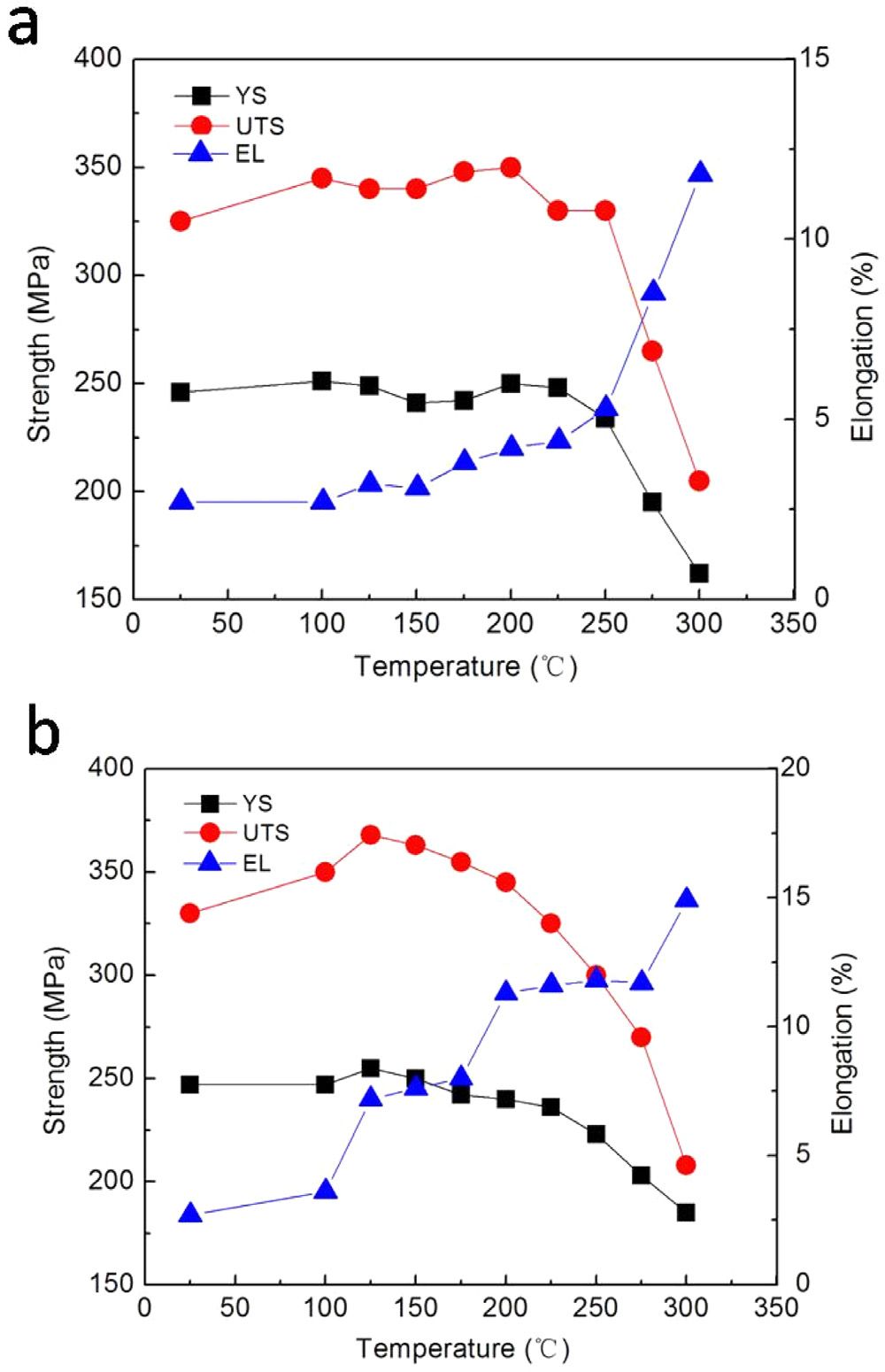大型复杂结构镁合金构件常采用低压砂型铸造工艺生产,在常规固溶水淬热处理过程中(即使水温达到90℃以上),由于铸件不同部位冷却速度差异而引起应力不均,进而容易产生微裂纹甚至开裂;此外,这类铸件通常在高速或超高速环境下服役,对其高温力学性能提出了更高的要求。探索一种既能避免铸件开裂,又具有较高室温和高温力学性能的最佳T6热处理工艺,这对于大型复杂结构镁合金构件的应用意义重大,有利于推广镁合金的应用。
近日,来自中国上海交通大学的丁文江院士团队,针对大型复杂结构Mg-10Gd-3Y-0.5Zr镁稀土合金铸件研制过程中存在的关键技术难题,提出了基于空冷的T6热处理思路,分别开发出了基于高强度和高强塑镁合金的T6热处理工艺参数,解决了大型复杂结构镁稀土合金铸件热处理过程中开裂的难题。此外,该热处理参数可确保铸件力学性能不降低,满足了其技术指标要求。同时,研究发现砂型铸造Mg-10Gd-3Y-0.5Zr合金存在高温力学性能超常现象,即屈服强度和抗拉强度均随实验温度的升高先上升而后降低,延伸率随温度升高而持续增加。在525℃×12h+225℃×14h处理下,室温屈服强度、抗拉强度和延伸率分别达到了252MPa、340MPa、1.6%,200℃时的屈服强度、抗拉强度和延伸率分别达到了250MPa、350MPa、4.6%。在525℃×12h+250℃×12h处理下,室温屈服强度、抗拉强度和延伸率分别达到了247MPa、360MPa、2.7%,125℃时的屈服强度、抗拉强度和延伸率分别达到了255MPa、368MPa、7.0%。砂型铸造Mg-10Gd-3Y-0.5Zr合金特别适于在高温条件下使用。
该研究成果发表在《Journal of Magnesium and Alloys》2019年第7卷第4期: [1] W. Liu, B. Zhou, G. Wu, L. Zhang, X. Peng, L. Cao. High temperature mechanical behavior of low-pressure sand-cast Mg–Gd–Y–Zr magnesium alloy. Journal of Magnesium and Alloys. 2019, 7, 597-604 其摘要翻译及原文如下: 摘要: 该文以砂型铸造Mg-10Gd-3Y-0.5Zr合金为研究对象,首先优化了固溶后采用空冷冷却方式时合金的最佳T6热处理工艺,并系统研究了各种状态合金的微观组织和室温力学性能。然后基于优化的T6热处理工艺,研究了合金在室温至300℃范围内的拉伸力学性能和断裂行为,探索了高温强度超常现象的机理。结果表明,综合考虑大型复杂结构铸件对Mg-10Gd-3Y-0.5Zr合金高强度或高强塑的不同要求,砂型铸造合金基于空冷的最佳T6热处理工艺分别为525℃×12h+225℃×14h和525℃×12h+250℃ ×12h。T6处理合金的强度在室温至300℃之间表现出明显的反常温度效应,即合金屈服强度和抗拉强度均随拉伸温度的升高先升高而后降低,延伸率随实验温度单调增加。随着试验温度的升高,合金的拉伸断裂方式由穿晶断裂转变为沿晶断裂。
Abstract:
The aim of this work is firstly to optimize T6 heat-treatment of low-pressure sand-cast Mg–10Gd–3Y–0.5Zr alloy, and then systematically investigate the mechanical behavior of the T6-treated alloy from room temperature to 300 °C. It turned out that the optimum T6 heat-treatments for the tested alloy are 525 °C ×12 h + 225 °C ×14 h and 525 °C ×12 h + 250 °C ×12 h which integrated age-hardening and tensile properties into account, respectively. The strength of the T6-treated alloy indicates obvious anomalous temperature dependence from room temperature to 300 °C, namely both ultimate tensile strength and yield strength of the tested alloy firstly increase with tensile temperature, and then decrease as temperature increases further. Elongation increased with temperature monotonously. The tensile fracture mode of the tested alloy changes from transgranular fracture to intergranular fracture with the increasing of test temperature.
